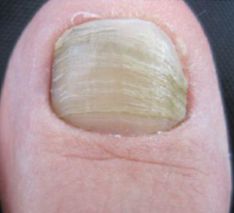Thickened Toenails
Thickened Toenails
Thickened toenails can be both unsightly and uncomfortable. They are a common issue that can affect people of all ages, though they tend to be more frequent among older adults. Understanding the causes, treatments, and preventative measures for thickened toenails can help manage this condition and improve foot health.y
Causes of Thickened Toenails
There are several reasons why toenails can become thickened. The most common cause is a fungal infection, known as onychomycosis, which leads to thick, discoloured, and brittle nails. Fungi thrive in warm, moist environments, making the toenails particularly susceptible to infection, especially if they are frequently exposed to such conditions. The infection causes the nail to become thick, yellow, and sometimes crumbly, as the fungus invades the nail bed.
Another common cause of thickened toenails is trauma or injury to the toenail. Repeated pressure from ill-fitting shoes or an acute injury can cause the nail to thicken over time as part of the body’s natural healing response. For instance, athletes who run long distances or people who spend significant time standing may be more prone to this type of nail thickening due to repetitive stress on the toes.
Ageing is another factor contributing to thickened toenails. As people age, their nails naturally become more brittle and grow more slowly, which can result in thicker nails. The circulation in the feet may also decrease with age, affecting the nails’ overall health. In some cases, older adults may also develop conditions like peripheral artery disease or diabetes, which can further impact nail growth and cause thickening.
Other conditions that can contribute to thick toenails include psoriasis, eczema, and other skin disorders that affect the nails. These conditions can cause the nail to thicken, become pitted, or take on an abnormal shape. In some cases, thickened toenails may be a sign of systemic conditions, such as a thyroid disorder or circulatory issues, where the nail health deteriorates as part of a broader problem.
Treatment for Thickened Toenails
The treatment of thickened toenails largely depends on the underlying cause. If a fungal infection is responsible, antifungal medications, either topical or oral, are commonly used. Topical treatments, such as antifungal creams, can be applied directly to the nail, while oral medications like terbinafine or itraconazole are used in more severe cases. It is important to follow the full course of treatment, which may take several months, as toenail infections can be slow to respond.
For thickened nails caused by trauma or pressure, it may be necessary to trim and file the nails regularly to reduce their thickness and prevent further damage. Using cushioning pads inside shoes and choosing footwear that provides adequate room for the toes can help minimize the impact on the nails. In some cases, a foot health practitioner may trim the nail more effectively, reduce the thickness using an electric bur, or advise other interventions.
In cases where thickening is caused by a skin condition like psoriasis or eczema, treatment typically involves managing the skin disorder with topical treatments, moisturisers, or prescribed medications. If necessary, a foot health practitioner or podiatrist may also remove a portion of the thickened nail.
In all of the above cases, if required, a foot health practitioner may reduce the thickness of the nails with the use of an electric bur (file), thus reducing any discomfort.
Prevention of Thickened Toenails
Preventing thickened toenails involves taking proactive steps to protect the health of your nails. One of the most important aspects of prevention is maintaining proper foot hygiene. Keeping the feet clean and dry is essential to prevent fungal infections. Wearing breathable socks made of materials like bamboo, cotton or wool can help wick moisture away from the feet, while choosing shoes that fit well and allow air circulation is crucial in preventing fungal growth..
Regularly trimming toenails and filing them to keep them at a manageable length can also help avoid trauma and excessive thickening. It is important to avoid cutting nails too short, as this can increase the risk of ingrown toenails or nail damage.
For individuals prone to fungal infections, applying antifungal powder or spray to the feet and shoes can be beneficial.
Finally, paying attention to any underlying health conditions, such as diabetes or circulation problems, and seeking appropriate medical care can help prevent nail health issues from arising or worsening.
Conclusion
Thickened toenails are a common yet manageable condition. Whether caused by fungal infections, injury, aging, or underlying health problems, there are several treatments available to restore nail health and improve comfort. By maintaining good foot hygiene, selecting the right footwear, and addressing any medical conditions, it is possible to prevent thickened toenails from becoming a persistent issue. If you notice changes in the appearance or health of your toenails, consulting with a foot health practitioner can help identify the cause and determine the best course of action.

